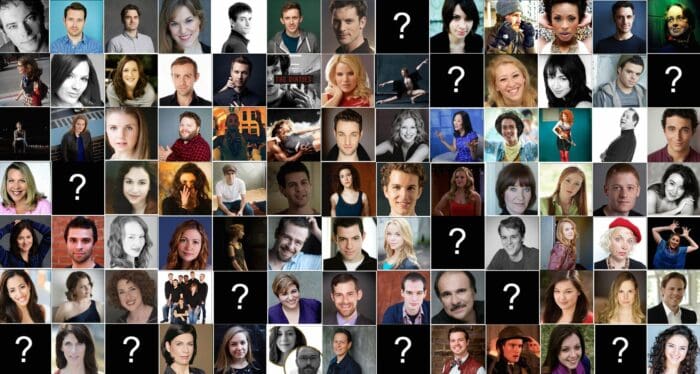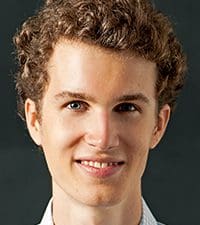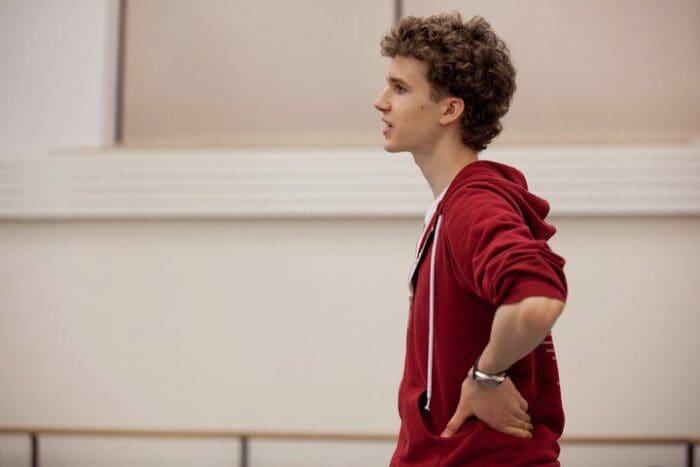 Before we announce the winners of the 2013 My Theatre Awards, we’re proud to present our annual Nominee Interview Series.
Before we announce the winners of the 2013 My Theatre Awards, we’re proud to present our annual Nominee Interview Series.
Choreographer Robert Binet was only 22 years old when his original ballet Unearth premiered in The National Ballet of Canada’s 2013 Innovation showcase alongside works from some of the most famous ballet names in the country (James Kudelka, Guillaume Cote and Jose Navas).
Highlighted by a stunning pas de deux from Best Ballet Performance nominees Skylar Campbell and Elena Lobsanova, Unearth was one of our favourite dance pieces of the year and earned the young choreographer his first My Theatre Award nomination for Best Ballet.
 Do you remember the first ballet you ever saw?
Do you remember the first ballet you ever saw?
The first ballet I ever saw was The National Ballet of Canada performing The Nutcracker. I was nine years old and was immediately determined to be a part of what I had seen on stage.
What is it about ballet specifically that made you want to pursue it professionally (perhaps over other dance forms)?
Ballet was the first form of dance I was introduced to, and although I tried other dance forms during my training and appreciate the new creative possibilities they offer me, ballet always has made the most sense to my body and mind. The classical technique opens the body up in a way that creates such pure and uncontrived expression of ideas and emotions.
While at the National Ballet School, was there a point where you had to choose between focusing on dance or on choreography? Do you still consider yourself as much a dancer as a choreographer?
I did decide in my last year of training to shift my focus entirely towards choreography. I always felt choreography was what I was going to spend most of my life doing, and as I grew older I became acutely aware of the fact that I was not comfortable as a performer. I did not enjoy being on stage and I felt that I could communicate with an audience much more effectively as a choreographer than as a dancer, which makes choreography so much more satisfying.
What performers and choreographers have always inspired you?
Of course the great choreographers like Balanchine and Ashton have always been of huge inspiration to me, but I am incredibly grateful to have had the opportunity to work with both John Neumeier and Wayne McGregor, two of the most important choreographers alive today. I was Wayne’s apprentice at The Royal Ballet for 18 months and I am so thankful for the incredible opportunities he has given me to learn and push myself as a choreographer, and for the support he continues to offer.
Do you have a favourite ballet?
It would be impossible to pick one. The more I love a ballet, the more complex my feelings about it become!
What was the first thing you ever choreographed?
As soon as I started dancing, I was making up dance, so it’s hard to say. The first piece I ever created that was performed in a theatre was for The Stephen Godfrey Choreographic Workshop at Canada’s National Ballet School when I was 13 years old.
You’ve had an amazing amount of success for someone so young. How did you catch the National Ballet’s attention as a choreographer worthy of the big stage at only 22?
Karen Kain, Artistic Director of The National Ballet of Canada, has been incredibly supportive of my work since I was in school. She gave me my first opportunity to work with professional dancers as a part of the company’s Choreographic Lab in 2011, and that led to me creating works for YouDance, the company’s outreach programme, and the annual fundraising gala. Karen’s openness to taking risks is something I am very appreciative of and I guess because she was impressed with what I created for her company and the way I worked with the dancers she thought it was time to give me a big push!
Do you have specific dancers you work particularly well with? What do you look for when casting an original piece?
Every choreographer has dancers they are particularly drawn to, whether it’s because they understand your ideas or coordination, there’s an emotional or musical connection, or because you like what new things you bring out in each other. These relationships with dancers are incredibly important to me and I am always so excited when I find a dancer I really connect with. When casting a new ballet, I look for dancers who move me in some way, who are musical, highly physical and who can connect with the people they are dancing with.
What would you say separates your style from other contemporary ballet choreographers?
I try not to think about what my ‘style’ is, but instead push myself in new and different directions with each piece of work I create. The fact that all the work comes from me means that a style will likely emerge. I’m happy if other people can identify common threads in my work, but trying to make myself recognize that style is, I think, a waste of time and could end up being creatively limiting.

Tell us about your My Theatre Award-nominated ballet Unearth. Where did the concept come from?
The concept for Unearth was scary for me because I was trying to create something that was at once very personal but also global in the ideas it explored. Composer Owen Pallett and I began by discussing this idea that when a civilization reaches a certain level of advancement, it can lose its curiosity and become inert. The piece, most simply put, is, in my mind, a quest to maintain curiosity and communication.
What were some of the challenges of staging such an ambitious piece?
I always try to make sure I have a new challenge for myself built in to every work I create, however with Unearth, there was no element of the entire project I felt I ‘knew how to handle’. But that is of course what made the process so exciting. I had worked with a composer on an original score before, and worked with a live orchestra before, but bringing the two together was a process that taught me a lot. It was the largest cast I had ever worked with up until that point, and to have my choice of the incredible National Ballet dancers was so exciting, but also daunting as I wanted to create something worthy of these brilliant artists. Working with the set and costume designer, Hyemi Shin, was such a joy but the process taught us both a lot as neither of us had ever worked in a space as large as the Four Seasons Centre before. Trying to get the proportions of the set right and the best balance of the colours and cuts in the costumes was a fascinating process. For me, learning how to create dance that is effective in such a large space and can communicate clearly with audiences that are much further from the dancers that I had been used to presented a steep learning curve. However, sorting through these challenges is what made the experience so valuable and satisfying.
Tell us about the creation and staging of that glorious pas de deux (Skylar Campbell is a Best Ballet Performance nominee for his performance in Unearth).
It was a true joy creating this duet with Skylar and Elena [Lobsanova]. Their duet was the pivotal point of the ballet and I knew that if the duet wasn’t strong and clear, the whole ballet wouldn’t make sense. Skylar and Elena are incredibly generous and creative people and they both have a true gift for communicating with their partners and with audiences. There is no artifice in their dancing, they are truly themselves on stage and in the studio, which is so inspiring to me.
There were actually three casts of that duet; it was also danced by Robert Stephen with Shino Mori and Harrison James with Hannah Fischer. The seven of us worked very collaboratively to create the movement and bring the ideas to life. Those rehearsals were some of the most creatively satisfying I’ve ever had and seeing how all three couples brought the piece to life was truly exciting for me.
Walk us through your process. You want to create a brand new ballet- now what?
The process is always different. Sometimes I am asked to create a work with specific stimuli or restrictions. This is good because nothing engenders creativity more than restrictions. Other times, as with the Innovation programme, I was given an open brief which is exciting, but daunting. I always have various ideas that are at different stages of development, and sometimes one of these will fit the opportunity, and other times I begin from scratch. I always start searching for music, sometimes to fit a specific idea, or sometimes in hopes that the music will lead me towards a concept. I love it when I know from the beginning what dancers I will be working with because then I can build the ideas from and around the people who will be performing it.
How do you choose your music?
I look for music that excites me. Everyone has a very visceral connection to music, so you know when it moves you and when it doesn’t. The nicest way is when as soon as I hear a piece of music, images start flooding into my mind, but I find it equally valuable to work with music that challenges me; music that upon the first listen I think I have no idea what I would do.
For Unearth, I commissioned Owen Pallett to write an original score, which was incredibly exciting, but it means you are really dealing in the unknown. I didn’t have all of the music until the end of my first week of rehearsals which meant that I went into the process with my concept really clear, but the movement and structure of the ballet not as clearly mapped out as I do normally. This was a good thing as it led to me creating spontaneously and very collaboratively with the dancers.
When you’re staging a new work for the first time, how much does the rehearsal process and the original cast affect change?
I create ballets because people and what they have to express fascinates me, so the ballet is always built around the dancers and created collaboratively with them.
Is it stressful having to translate your vision for another dancer to embody? Has there ever been something that came out completely differently than it existed in your head?
Yes, but this is the beauty of working with dancers. I get sick of what’s in my own head, and having so many different dancers to work with pushes me constantly in new directions. It’s like having a conversation; even if you plan to discuss the same thing, the conversation is going to go in a very different direction depending on who you’re having it with.
If you were to choreograph a full-length narrative ballet. What story would you adapt?
There are many stories I’m interested in adapting for ballet, but none I’m quite ready to talk about. I would love to collaborate with an author or playwright on a new story.
What is your favourite step in your choreographic toolbox?
As I move along in this profession, I’m learning that it’s not about the specific steps you use, but how you arrange the steps and connect them to music in order to make them speak. Of course there are movements that flow more naturally from my body; I love fast, complex footwork and partnering that really flies.
What do you think is the best work you’ve ever choreographed?
I have very complicated relationships with all the works I have choreographed, partly because they are all linked in my mind to where I was in my personal life at that time. There are of course ones I am more proud of, but this shifts over time, and is often not in line with which works have been the ‘most successful’.
What are you working on now?
I’m currently creating new works for Canada’s National Ballet School and The National Ballet, as well as small pieces in the UK and some exciting projects outside of the dance world.
